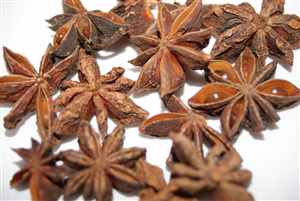Anise (Pimpinella Anisum)
Main Facts about Anise

Using Anise
Anise is still recommended as a digestive aid and to cure bad breath. Sip Anise tea after meal to improve digestion, prevent flatulence and colic. Since Hipporates' times Anise has been used for coughs, especially for dry cough, and bronchitis. The essential oil of the seed works as a mild expectorant. Anise has also a mild antimicrobial effect. It has been used in cough medications. Anise has been used to treat menstrual cramps. Consumption of the Anise seeds increases milk in lactating women while simultaneously relieving their infants from gastrointestinal problems. Anise seeds are considered to be a mild diuretic. The essential oil of Anise (especially mixed with the oil of Sassafras and Carbolic oil) is used as insecticide. Recent studies, performed on the extracts and essential oil of Anise, identified such pharmacological properties of this plant as antimicrobial, antifungal, antiviral, antioxidant, and insecticidal. The findings also revealed that Anise has hypoglycemic and hypolipidemic effects and reduces lipid peroxidation in diabetic patients. Furthermore, Anise seeds showed anticonvulsant effect, reduced morphine dependence, and induced conditioned place aversion in mice. Since the essential oil is poisonous for many insects, ointments containing Anise have also be used as a natural treatment for scabies and lice infestations.Anise is a remedy for: Cold and flu
Caution!
High doses of the essential oil of Anise are toxic due to its narcotic properties especially if it has not been stored properly. Anise is safe to use in small doses but in large amount Anise seeds can cause nausea, vomiting, diarrhea, wheezing or shortness of breath. Anise may reduce the effectiveness of hormone-based therapies. Anise may also reduce the effectiveness of tamoxifen, a drug used to treat certain types of cancer.Cooking with Anise
To make Anise tea you can use the seeds (whole or ground) or dried leaves. Steep a teaspoon in a cup of boiled water ofr 10 min. Drink a sip at a time after a meal. Anise leaves can be shopped and added to salads or used as a garnish. Anise seeds are widely used in many different cuisines for their aromatic flavor. They are also used to flavor various liqueurs.How to grow Anise
Anis grows best in light, dry, well-drained soil in full sun. Since it has a long taproot and is difficult to transplant, it is propageted from seeds. Seeds should be planted in spring as sonn as the ground is warm. The seeds require temperature 70F to germinate. Anis is easily damaged by wind, it needs a sheltered, weed-free location to grow. To harvest the seeds cut the whole seed heads after they have ripened, but before they have broken open.| Angelica |
Arnica
|